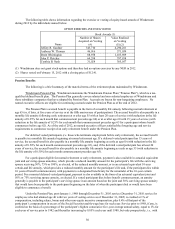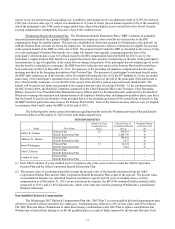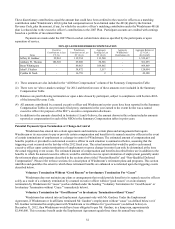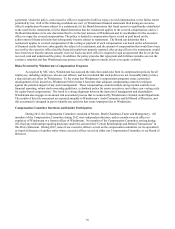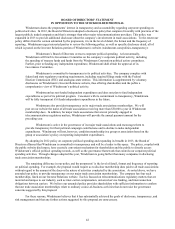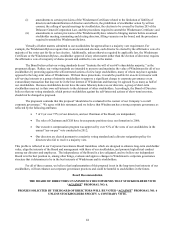Windstream 2012 Annual Report Download - page 46
Download and view the complete annual report
Please find page 46 of the 2012 Windstream annual report below. You can navigate through the pages in the report by either clicking on the pages listed below, or by using the keyword search tool below to find specific information within the annual report.
xNo equity awards vest solely upon signing, receipt of shareholder approval, or consummation of a change-in-control
transaction (i.e., no single-trigger vesting);
xAs stated in the proposal, all awards to senior executives have a double-trigger vesting provision, which means
vesting does not occur unless both (1) the change-in-control transaction is consummated and (2) the executive's
employment is terminated following the transaction. Additionally, the first trigger is tied to consummation (and not
signing or shareholder approval) of a change-in-control transaction;
xNo awards vest unless the executive's position is eliminated in a qualified manner (i.e., termination by the company
without cause, or resignation by the executive for good reason);
xNo awards contain a window period provision that vest the award if the executive resigns within a specified time
period following closing of a change-in-control transaction; and
xOur change-in-control agreements with executive officers limit the amount of all change-in-control severance
benefits (including the value of any unvested equity awards) so that they do not exceed the applicable limit under
280G of the Internal Revenue Code, and no executives are eligible for gross-up or reimbursement of any excise
taxes.
Windstream believes that it is appropriate for equity-based compensation to vest under this qualified double-trigger
framework because, in most change-in-control transactions, senior executive positions of the target company are eliminated
as duplicative following the closing of the transaction. As a result of these alternative scenarios, if compensation programs
are not properly designed, the risk of loss of a substantial portion of executive compensation can discourage management
from pursuing the best alternatives for creating long-term value for shareholders, including a potential change-of-control
transaction, while encouraging pursuit of alternatives more likely to result in longer term employment of the executive team.
Due to this potential conflict, we believe that well-designed change-in-control arrangements are an important measure to
align management’s interests with stockholders. The conflict is potentially greater at Windstream due to the substantial
amount of merger and acquisition activity that occurs in our sector, as well as Windstream’s practice of allocating a
substantial percentage of each executive’s annual total direct compensation to equity compensation.
One unintended consequence of adopting the proposal would be to undermine the retention incentive of equity
awards, as management would face the prospect of forfeiture of all or a substantial portion of their equity awards in the event
of a change-in-control. The need for this retention incentive is heightened during the pendency of a change-in-control, as a
target company needs a motivated executive team to continue to operate the business during the period between signing and
closing. The need for this retention incentive is especially great in Windstream’s industry due to the significant time periods
that can elapse before obtaining regulatory approvals for a transaction. We note that none of the companies cited by the
proponent as adopting its proposal is a company operating in Windstream’s sector, and adoption of this policy could
disadvantage Windstream within its sector.
If Windstream were to pursue a change-in-control transaction, the Board of Directors would choose such alternative
in the belief that it was the best path for creating long-term value for Windstream stockholders. Under those circumstances,
the Board does not believe it is appropriate, or in the best interest of our stockholders for the reasons discussed above, for
senior management to forfeit their unvested equity awards that represent a significant portion of their total annual
compensation.
For these reasons, Windstream believes that this proposal is unnecessary and undesirable and could have adverse
consequences for stockholders.
Board Recommendation
THE BOARD OF DIRECTORS UNANIMOUSLY RECOMMENDS THAT STOCKHOLDERS VOTE “AGAINST”
PROPOSAL NO. 4.
PROXIES SOLICITED BY THE BOARD OF DIRECTORS WILL BE VOTED “AGAINST” PROPOSAL NO. 4
UNLESS STOCKHOLDERS SPECIFY A CONTRARY VOTE.
40


